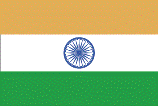Geography >> Asia >> India History and Timeline
India
Capital: New Delhi
Population: 1,366,417,754
The Geography of India
Borders: China, Bhutan, Nepal, Pakistan, Bangladesh, Indian Ocean
Total Size: 3,287,590 square km
Size Comparison: slightly more than one-third the size of the US
Geographical Coordinates: 20 00 N, 77 00 E
World Region or Continent: Asia
General Terrain: upland plain (Deccan Plateau) in south, flat to rolling plain along the Ganges, deserts in west, Himalayas in north
Geographical Low Point: Indian Ocean 0 m
Geographical High Point: Kanchenjunga 8,598 m
Climate: varies from tropical monsoon in south to temperate in north
Major Cities: NEW DELHI (capital) 21.72 million; Mumbai 19.695 million; Kolkata 15.294 million; Chennai 7.416 million; Bangalore 7.079 million (2009)
Major Landforms: Himalayan Mountain Range, Punjab Plain,Thar Desert, Chin Hills, Khasi Hills, Deccan Plateau, Mount Kangchenjunga, Coastal Plains
Major Bodies of Water: Ganges River, Brahmaputra River, Godavari River, Wular Lake, Chilika Lake, Loktak Lake, Bay of Bengal, Arabian Sea, Laccadive Sea, Indian Ocean

Taj Majal
Economy of India
Major Industries: textiles, chemicals, food processing, steel, transportation equipment, cement, mining, petroleum, machinery, software
Agricultural Products: rice, wheat, oilseed, cotton, jute, tea, sugarcane, potatoes; cattle, water buffalo, sheep, goats, poultry; fish
Natural Resources: coal (fourth-largest reserves in the world), iron ore, manganese, mica, bauxite, titanium ore, chromite, natural gas, diamonds, petroleum, limestone, arable land
Major Exports: textile goods, gems and jewelry, engineering goods, chemicals, leather manufactures
Major Imports: crude oil, machinery, gems, fertilizer, chemicals
Currency: Indian rupee (INR)
National GDP: $4,421,000,000,000
Government of India
Type of Government: federal republic
Independence: 15 August 1947 (from UK)
Divisions: India is divided up into 29 states and 7 union territories. The largest of the Indian states by population are Uttar Pradesh, Maharashtra, and Bihar. As of 2011 Uttar Pradesh had a population of around 200 million. The largest states by area are Rajasthan, Madhya Pradesh, and Maharashtra. The capital city of Delhi is considered a union territory.
National Anthem or Song: Jana-Gana-Mana (Thou Art the Ruler of the Minds of All People)
National Symbols:
- Animal - Bengal tiger
- Bird - Peacock
- Reptile - King cobra
- Aquatic animal - Ganges River dolphin
- Tree - Banyan tree
- Fruit - Mango
- Emblem - Three lions from the Lion Capital of Ashoka
- Motto - Truth alone triumphs
- Other symbols - River Ganges, Indian elephant, Taj Majal
Description of flag: The Indian flag, called the Tricolour, was adopted on July 22, 1947. It consists of three horizontal stripes of saffron (top), white (middle), and green (bottom). At the center is a navy blue wheel with 24 spokes called the Ashoka Chakra. The color saffron represents courage and sacrifice, the color white stands for truth and purity, and the color green represents prosperity.
National Holiday: Republic Day, 26 January (1950)
Other Holidays: There are a number of holidays celebrated in India. Which holidays are celebrated depends on the religion and area where a person lives. The three national holidays are Republic Day (January 26), Independence Day (August 15), and Mahatma Gandhi's Birthday (October 2). Other popular holidays and celebrations include Raksha Bandhan, Navratri, Diwali, Eid ul-Fitr, Eid al-Adha, Easter, and Christmas (December 25).
The People of India
Languages Spoken: English enjoys associate status but is the most important language for national, political, and commercial communication; Hindi is the national language and primary tongue of 30% of the people; there are 14 other official languages: Bengali, Telugu, Marathi, Tamil, Urdu, Gujarati, Malayalam, Kannada, Oriya, Punjabi, Assamese, Kashmiri, Sindhi, and Sanskrit; Hindustani is a popular variant of Hindi/Urdu spoken widely throughout northern India but is not an official language
Nationality: Indian(s)
Religions: Hindu 80.5%, Muslim 13.4%, Christian 2.3%, Sikh 1.9%, other 1.8%, unspecified 0.1% (2001 census)
Origin of the name India: The name "India" comes from the Persian word "Indus" for Hindus. The people of India generally refer to their country as Bharat or Hindustan. Bharat is an official name called out in the Indian Constitution.

Mahatma Gandhi
- Akbar the Great - Mughal Emperor
- Amitabh Bachan - Actor
- Satyendra Bose - Physicist
- Deepak Chopra - Author and doctor
- Indira Gandhi - Prime Minister of India
- Mahatma Gandhi - Civil rights activist
- Shahrukh Khan - Actor
- Narayan Murthy - Entrepreneur
- Jawaharlal Nehru - World leader and India's first prime minister
- Aishwarya Rai - Actress
- Ravi Shankar - Musician
- Sachin Tendulkar - Cricket player
- Mother Teresa - Civil rights activist
Geography >> Asia >> India History and Timeline
** Source for population (2019 est.) is United Nations. GDP (2011 est.) is CIA World Factbook.




